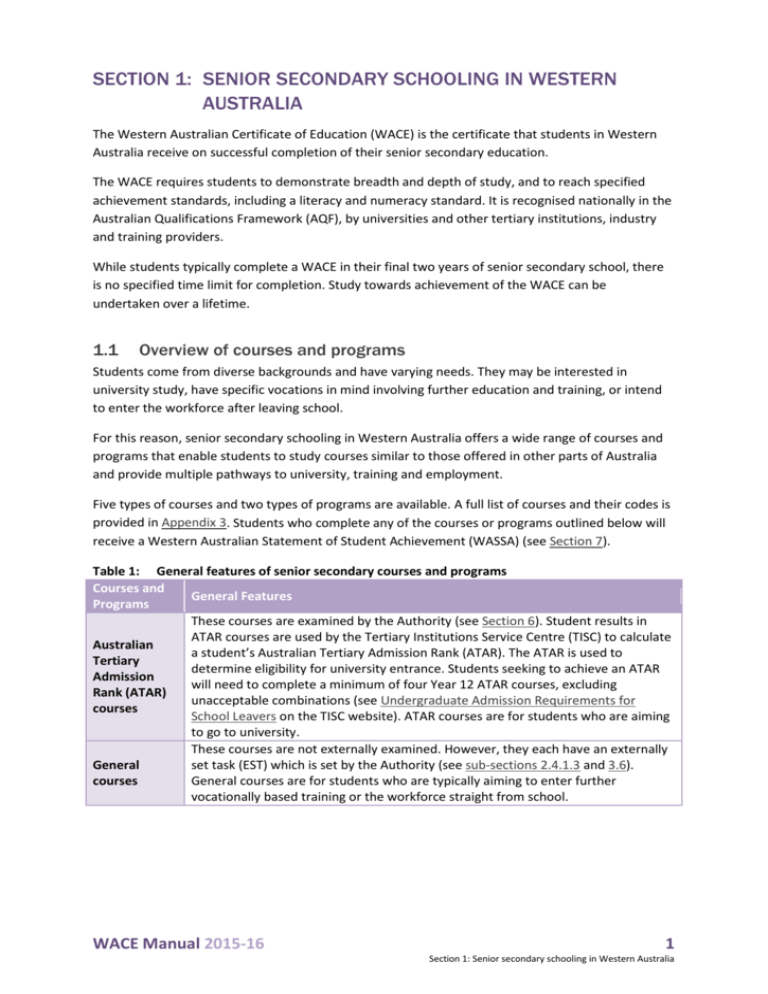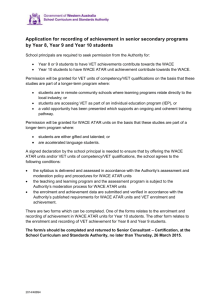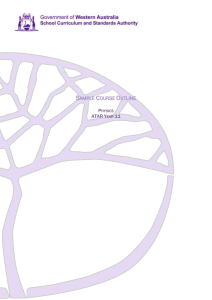Section 1 of the WACE Manual 2015-16
advertisement

SECTION 1: SENIOR SECONDARY SCHOOLING IN WESTERN AUSTRALIA The Western Australian Certificate of Education (WACE) is the certificate that students in Western Australia receive on successful completion of their senior secondary education. The WACE requires students to demonstrate breadth and depth of study, and to reach specified achievement standards, including a literacy and numeracy standard. It is recognised nationally in the Australian Qualifications Framework (AQF), by universities and other tertiary institutions, industry and training providers. While students typically complete a WACE in their final two years of senior secondary school, there is no specified time limit for completion. Study towards achievement of the WACE can be undertaken over a lifetime. 1.1 Overview of courses and programs Students come from diverse backgrounds and have varying needs. They may be interested in university study, have specific vocations in mind involving further education and training, or intend to enter the workforce after leaving school. For this reason, senior secondary schooling in Western Australia offers a wide range of courses and programs that enable students to study courses similar to those offered in other parts of Australia and provide multiple pathways to university, training and employment. Five types of courses and two types of programs are available. A full list of courses and their codes is provided in Appendix 3. Students who complete any of the courses or programs outlined below will receive a Western Australian Statement of Student Achievement (WASSA) (see Section 7). Table 1: General features of senior secondary courses and programs Courses and General Features Programs These courses are examined by the Authority (see Section 6). Student results in ATAR courses are used by the Tertiary Institutions Service Centre (TISC) to calculate Australian a student’s Australian Tertiary Admission Rank (ATAR). The ATAR is used to Tertiary determine eligibility for university entrance. Students seeking to achieve an ATAR Admission will need to complete a minimum of four Year 12 ATAR courses, excluding Rank (ATAR) unacceptable combinations (see Undergraduate Admission Requirements for courses School Leavers on the TISC website). ATAR courses are for students who are aiming to go to university. These courses are not externally examined. However, they each have an externally General set task (EST) which is set by the Authority (see sub-sections 2.4.1.3 and 3.6). courses General courses are for students who are typically aiming to enter further vocationally based training or the workforce straight from school. WACE Manual 2015-16 1 Section 1: Senior secondary schooling in Western Australia Courses and Programs Vocational Education and Training (VET) industry specific courses General Features These courses include a full AQF qualification, mandatory workplace learning and contribute to the Certificate II requirement for a WACE. VET industry specific courses are for students aiming to enter further vocationally based training or the workforce straight from school. These courses provide a focus on functional literacy and numeracy skills, practical work‐related experience and the opportunity to build personal skills that are important for life and work. The Foundation courses are not designed, nor Foundation intended, to be an alternative senior secondary pathway. Foundation courses are courses for students who have not been able to demonstrate the minimum standard for literacy and/or numeracy (see sub-section 1.6) before Year 11 and are unlikely to do so before the end of Year 12 without significant levels of student support. Preliminary courses are for students who have been identified as having a learning difficulty and/or an intellectual disability (see sub-section 1.7). They provide a relevant option for students who: • cannot access the ATAR, General or Foundation course content with adjustment and/or disability provisions Preliminary courses • are unable to progress directly to training from school • require modified and/or independent education plans • have been identified as having a recognised disability under the Disability Discrimination Act 1992 and meet the above criteria. Preliminary courses do not contribute to achievement of the WACE. VET qualifications are for students wishing to participate in nationally recognised Vocational training. All VET qualifications require registered training organisation (RTO) Education and delivery, assessment and quality control under the relevant VET regulatory body Training (VET) (see Section 4). A Certificate II or higher is one of the range of requirements for qualifications achieving a WACE. These qualifications contribute to the WACE as unit equivalents. These programs provide access to areas of learning not covered by WACE courses or VET programs and contribute to the WACE as unit equivalents (see Section 5). Endorsed Endorsed programs are for students wishing to participate in programs which are programs delivered in a variety of settings by schools, workplaces, universities and community organisations. ATAR, General and Foundation courses are offered at two year levels – Year 11, comprising Units 1 and 2, and Year 12, comprising Units 3 and 4. The different certificates (I, II and III) available through VET industry specific courses are packaged as two or four units. For ATAR, General, and Foundation courses, each unit is nominally 55 hours contact time. For VET industry specific courses, the unit time is dependent on the qualification and may require more than 55 hours per unit. For ATAR, General and Foundation courses: • the two Year 11 units are typically studied and reported to the Authority as a pair, but may be studied and reported separately • the two Year 12 units must be studied and reported to the Authority as a pair. WACE Manual 2015-16 2 Section 1: Senior secondary schooling in Western Australia Note: the Authority’s recommendation is for schools to enrol students in pairs of units in both Year 11 and Year 12. Where a student transfers between Year 11 courses or units after Semester 1 the school can report student achievement for two separate units (see sub-section 2.4.3). For VET industry specific courses, both Year 11 units and Year 12 units are reported as pairs. Preliminary courses comprise four units. Each unit is studied and reported separately. Some ATAR and General courses have defined contexts. These courses are: • Design: Dimensional Design, Graphics, Photography, and Technical Graphics (General only) • Materials Design and Technology: Metal, Textiles, Wood (ATAR and General) • Music: Contemporary, Jazz, Western Art (ATAR only). Each context consists of two Year 11 units (1 and 2) and two Year 12 units (3 and 4). For Design and Music, students can enrol in more than one context in each course with defined contexts, but only a maximum of four units will count towards WACE requirements and students can sit only one ATAR course examination for the course. For Materials Design and Technology, students can enrol in, and gain credit towards the WACE in up to eight Materials Design and Technology units - four at Year 11 and four at Year 12 across two defined contexts. The two options to achieve this are: Option 1 four ATAR course units (two at Year 11 and two at Year 12) in conjunction with four General course units from another defined context (two at Year 11 and two at Year 12) Option 2 eight General course units (four at Year 11 and four at Year 12) from two different, defined contexts. Students can sit only one ATAR course examination for the Materials Design and Technology course. 1.2 Course and program review and revision Courses are typically reviewed every five years. Initially, some courses will be reviewed sooner to enable all courses to be reviewed over a period of years. The review timeline for each course will be published on the Authority website. Where required the review will be followed by a revision of the syllabus. The most current training packages are used in VET industry specific courses and they are updated regularly as new versions are endorsed. The Authority follows all national guidelines provided for training package transition arrangements in Western Australia. Any changes made to training packages are reflected in timely amendments to information provided in the courses. WACE Manual 2015-16 3 Section 1: Senior secondary schooling in Western Australia 1.3 Summary of WACE achievement requirements General requirements Students must: • demonstrate a minimum standard of literacy and a minimum standard of numeracy • complete a minimum of 20 units or equivalents as described below • complete at least four Year 12 ATAR courses (excluding unacceptable combinations) or complete* a Certificate II (or higher) VET qualification. Note: the partial completion of a Certificate III or higher VET qualification may meet this requirement according to predetermined criteria (see Section 4). *Note: In the context of VET in the WACE, the term ‘complete’ requires that a student has been deemed competent in all units that make up a full qualification. Breadth and depth Students must • complete a minimum of 20 units or the equivalent. This requirement must include at least: o a minimum of ten Year 12 units or the equivalent o two completed Year 11 units from an English course and one pair of completed Year 12 units from an English course o one pair of Year 12 units from each of List A (arts/languages/social sciences) and List B (mathematics/science/technology). Achievement standard Students must achieve 14 C grades (or equivalents, see below) in Year 11 and Year 12 units, including at least six C grades in Year 12 units (or equivalents). Unit equivalence Unit equivalence can be obtained through VET qualifications and/or endorsed programs. The maximum unit equivalence available through these programs is eight units – four Year 11 units and four Year 12 units. Students may obtain unit equivalence as follows: • up to eight unit equivalents through completion of VET qualifications, or • up to four unit equivalents through completion of endorsed programs, or • up to eight unit equivalents through a combination of VET qualifications and endorsed programs, but with endorsed programs contributing no more than four unit equivalents. For VET qualifications: • a Certificate I is equivalent to two Year 11 units • a Certificate II is equivalent to two Year 11 and two Year 12 units • a Certificate III or higher is equivalent to two Year 11 and four Year 12 units • a partially completed Certificate III or higher is equivalent to two Year 11 and two Year 12 units (credit only allocated if the criteria for partial completion is met). For endorsed programs, unit equivalence is identified on the Authority’s approved list of endorsed programs. WACE Manual 2015-16 4 Section 1: Senior secondary schooling in Western Australia 1.4 Study options for the WACE In selecting their study options for the WACE, students must bear in mind: • the List A and List B subject requirement (see Section 7) • the enrolment criteria (eligibility) for Languages and English as an Additional Language or Dialect (forms and information are available on the Authority website) • the enrolment criteria for Foundation courses (see sub-section 1.6). Students wishing to receive an ATAR are required to complete a minimum of four ATAR courses in Year 12, excluding unacceptable combinations (see Section 7). Because syllabus content of a course increases in complexity from Year 11 to Year 12, a student is not permitted to complete Year 12 units in a course and subsequently enrol in Year 11 units in the same course. Students should also be aware that if they choose to study more than four units in different courses in a particular subject (e.g. Physics ATAR and Physics General), only four units in total will contribute towards achievement of the WACE for any one subject. The following are examples of some study options for students. Table 2: Examples of study options Student Courses and programs A B C D E six Year 11 ATAR courses five Year 12 ATAR courses four Year 11 ATAR courses two Year 11 General or Foundation courses four Year 12 ATAR courses two Year 12 General or Foundation courses four Year 11 ATAR courses two Year 11 General or Foundation courses two Year 12 ATAR courses four Year 12 General or Foundation courses four Year 11 ATAR courses two Year 11 General or Foundation courses one Year 12 ATAR course two Year 12 General or Foundation courses VET Certificate II – attributed to Year 11 (two unit equivalents) and Year 12 (two unit equivalents) Endorsed program: Workplace Learning (two units, 110 hours) – attributed to Year 12 four Year 11 General or Foundation courses VET Certificate I – attributed to Year 11 (two unit equivalents) four Year 12 General or Foundation courses VET Certificate II – attributed to Year 11 (two unit equivalents) and Year 12 (two unit equivalents) WACE Manual 2015-16 Eligibility for WACE certification Yes (22 units, 10 Year 12) Eligibility for ATAR Yes* Yes (24 units, 12 Year 12) Yes* No (24 units, 12 Year 12) missing a Certificate II or higher No Yes (24 units, 10 Year 12) No Yes (22 units, 10 Year 12) No 5 Section 1: Senior secondary schooling in Western Australia Student F G H I Courses and programs four Year 11 General or Foundation courses Certificate II VET industry specific course* – attributed to Year 11 (two course units) and Year 12 (two course units) four Year 12 General courses Endorsed program: Workplace Learning (two units, 110 hours) – attributed to Year 12 three Year 11 General or Foundation courses Certificate I – attributed to Year 11 (two unit equivalents) four Year 12 General or Foundation courses VET Certificate II – attributed to Year 11 (two unit equivalents) and Year 12 (two unit equivalents) Endorsed program: Workplace Learning (two units, 110 hours) – attributed to Year 12 three Year 11 General or Foundation courses VET Certificate I – attributed to Year 11 (two unit equivalents) three Year 12 General or Foundation courses VET Certificate II – attributed to Year 11 (two unit equivalents) and Year 12 (two unit equivalents) Endorsed program: Workplace Learning (two units, 110 hours) – attributed to Year 12 four Year 11 General or Foundation courses four Year 12 General or Foundation courses VET Certificate III – attributed to Year 11 (two unit equivalents) and Year 12 (four unit equivalents) Endorsed program: Workplace Learning (two units, 110 hours) – attributed to Year 11 Eligibility for WACE certification Eligibility for ATAR Yes (20 units, 10 Year 12) Certificate II completed as part of VET industry specific course No Yes (22 units, 12 Year 12) No Yes (20 units, 10 Year 12) No Yes (24 units, 12 Year 12) No *Note: excluding unacceptable combinations (see Undergraduate Admission Requirements for School Leavers on the TISC website). 1.5 School-based achievement A student’s school‐based achievement in ATAR, General and Foundation courses is recorded in grades (A, B, C, D or E) and marks out of 100 (see Section 2). A student’s school-based achievement for a Year 12 course must be recorded for a pair of units i.e. one mark and one grade. A student’s school-based achievement for a Year 11 course may be recorded for each pair of units (i.e. one mark and grade), or for each unit completed (i.e. two marks and two grades). Student achievement in Preliminary course units is recorded as ‘completed’ or ‘not completed’. Student achievement in VET industry specific courses is recorded as ‘completed’ upon completion of all course requirements. The notation ‘completed’ counts as a C grade for the WACE requirements. Student achievement in VET programs is competency‐based and specific requirements are outlined in national training packages or accredited courses (see Section 4). WACE Manual 2015-16 6 Section 1: Senior secondary schooling in Western Australia Student achievement in endorsed programs is reported as the particular program that has been completed (see Section 5). 1.6 Eligibility for Foundation courses There are two ways in which students can demonstrate the minimum standard of literacy and numeracy: prequalification through Year 9 National Assessment Program Literacy and Numeracy (NAPLAN); or performance in the Online Literacy and Numeracy Assessment (OLNA). Students who have demonstrated: • the minimum standard of literacy in Year 10 are not eligible to enrol in Foundation English and other List A Foundation courses in Year 11 • the minimum standard of numeracy in Year 10 are not eligible to enrol in Foundation Mathematics and other List B Foundation courses in Year 11. Students who have not demonstrated: • the minimum standard of literacy through Year 9 NAPLAN and have not sat the OLNA are not eligible to enrol in Foundation English and other List A Foundation courses • the minimum standard of numeracy through Year 9 NAPLAN and have not sat the OLNA are not eligible to enrol in Foundation Mathematics and other List B Foundation courses. Students who demonstrate: • the minimum standard of literacy and/or numeracy in Semester 1 of Year 11 are not eligible to continue in the associated Foundation courses in Semester 2 of that year • the minimum standard of literacy in Semester 2 of Year 11 or during Year 12 will be permitted to continue in Foundation English and other List A Foundation courses in Year 12 • the minimum standard of numeracy in Semester 2 of Year 11 or during Year 12 will be permitted to enrol in Foundation Mathematics and other List B Foundation courses in Year 12. 1.7 Eligibility for Preliminary courses Enrolment in Preliminary courses is restricted to students who have been identified as having a learning difficulty, intellectual disability or a severely disrupted learning pathway. In this context, a severely disrupted learning pathway may be considered as one where the student may not have a diagnosed disability, but has severe social/emotional issues that have required intervention and/or action by an appropriate specialist medical professional/s. Schools may be asked to provide evidence to the Authority through an audit process for students they enrol in these courses. Importantly, Preliminary courses do not contribute towards the achievement of a WACE. Enrolling students in Preliminary courses unnecessarily will considerably reduce their opportunity to achieve a WACE. 1.8 Special education needs The Authority provides a range of support for students with special education needs. These are students who have been identified as having a recognised disability under the Disability Discrimination Act 1992 and who, as a consequence of their disability: WACE Manual 2015-16 7 Section 1: Senior secondary schooling in Western Australia • • • cannot access the ATAR, General or Foundation course content with adjustment and/or disability provisions, or are unable to progress directly to training from school, or require modified and/or independent education plans. As with all students, students with special education needs have the opportunity to complete a WACE over a lifetime. Options available to them include workplace learning, VET programs, ASDAN modules (from the UK-based Award Scheme Development and Accreditation Network) and Preliminary courses that have been specifically developed by the Authority. Preliminary courses are restricted to students with special education needs. They are designed to accommodate the broad range of abilities of students with special needs and to allow for adapted approaches to teaching and learning. Each Preliminary course comprises units that are described in each syllabus. Students are not required to attempt all four units. Teachers are best placed to decide how many and which units to include within the individual learning plan for each student. Preliminary units in themselves do not contribute to the requirements for the WACE. Schools report on each student’s work for a unit as either completed or not completed. However, students undertaking Preliminary units may also undertake workplace learning, VET and ASDAN modules, all of which do contribute to the WACE. Information on the support available to schools for students with special education needs is provided in Appendix 2. A full list of Preliminary courses and their codes is provided in Appendix 3. WACE Manual 2015-16 8 Section 1: Senior secondary schooling in Western Australia








